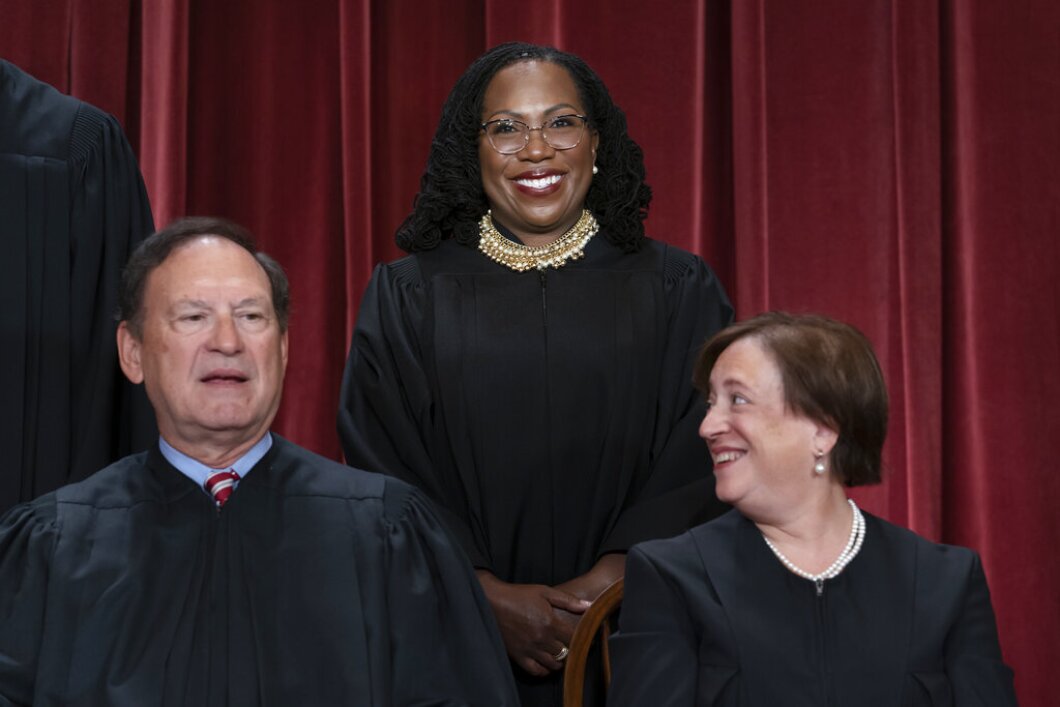
Supreme Court Justice Ketanji Brown Jackson has likely finished writing decisions on the merits this term after the newest arrival to the high court wrote her sixth majority opinion last week.
With just 18 cases left to decide this term, Jackson wrote her latest opinion on Friday in Lora v. United States, making her the justice with the most authored opinions this term so far.
SUPREME COURT NEWS: JUSTICES SAVE ‘CLOSELY WATCHED’ CASES FOR END OF JUNE

It would be “totally normal” for Jackson to complete the term with six written opinions on the merits, professor Jonathan Adler of Case Western University Law School told the Washington Examiner, noting the Supreme Court typically attempts to “equalize the case assignments” among the nine justices, or divide them equally.
The court has historically agreed to hear upwards of 100 cases per term, but this has declined in recent years. This term, justices agreed to weigh 60 individual matters but removed one case from the argument calendar earlier this year.
After the unanimous ruling in Lora last week, which held defendants convicted in gun crimes can serve concurrent sentences, Adler tweeted that Jackson is “likely done” authoring opinions for the term given that justices including Amy Coney Barrett, Neil Gorsuch, and Elena Kagan have only written five opinions each this term.
Justice Jackson leads the pack on #SCOTUS with six majority opinions so far this term. (Three justices–ACB, NG, EK– have written five.) She’s likely done with majority ops for the term too.
— Jonathan H. Adler (@jadler1969) June 16, 2023
Of the six opinions Jackson has written this term, four of them were on unanimous decisions. Adler said it’s typical for new justices to decide fewer “contentious” cases throughout the term, meaning they are more likely to garner unanimity among the full court. For this reason, Adler said her majority opinions “don’t tell us a lot about her jurisprudence.”
Adler pointed to a recent decision written by Barrett that preserved the Indian Child Welfare Act, noting he and other scholars acknowledged that was a “pretty big case” for a “relatively new justice” that joined the court in 2020.
As for Jackson’s jurisprudence during year one, her dissents have provided some clues as to where she might rule in future terms when she is assigned more contentious cases. For example, she wrote her first lengthy solo dissent on the merits earlier this month when the eight justices allowed a company to move forward with a complaint against a union for damaging cement products.
“Workers are not indentured servants, bound to continue laboring until any planned work stoppage would be as painless as possible for their masters,” Jackson wrote in part of her 27-page dissent.
Jackson also wrote a short dissent in November after the majority on the bench declined to consider the case of a death row inmate from Ohio whose lawyers said the state suppressed evidence that may have altered the outcome of his trial.
Nominated by President Joe Biden to succeed Justice Stephen Breyer last year, Jackson has already set records for the most words spoken during oral arguments as a first-term justice since 1990 and joined the court at an unusual time of uncertainty, given the dip in public approval ratings after the overturning of Roe v. Wade last year.
Evidence of increased harmony on SCOTUS? Last term there were 14 6-3 decisions along ideological lines, this term there have been 0 with 18 cases left. Last term 29% of the decisions were unanimous. This term > 54% unanimous so far. Image from @SCOTUSblog pic.twitter.com/WkanDNJX6U
— Dr. Adam Feldman (@AdamSFeldman) June 16, 2023
But while the 6-3 Republican-appointed majority court has largely saved its most divisive rulings for the final two weeks, such as decisions on the fate of affirmative action and Biden’s student loan forgiveness plan, the justices have notably not released one opinion on ideological lines so far this year.
“Last term there were 14 6-3 decisions along ideological lines, this term there have been 0 with 18 cases left. Last term 29% of the decisions were unanimous. This term > 54% unanimous so far,” Adam Feldman, Supreme Court scholar and founder of the Empirical SCOTUS blog, tweeted on June 16.
CLICK HERE TO READ MORE FROM THE WASHINGTON EXAMINER
But because the court has handled roughly 50-60 cases per term in recent years, that number doesn’t generally create a “representative cross-section of the range of issues the Court deals with” year after year, Adler said.
“It’s just a different mix of cases and a different mix of questions. And that produces a different mix of results,” Adler said.





